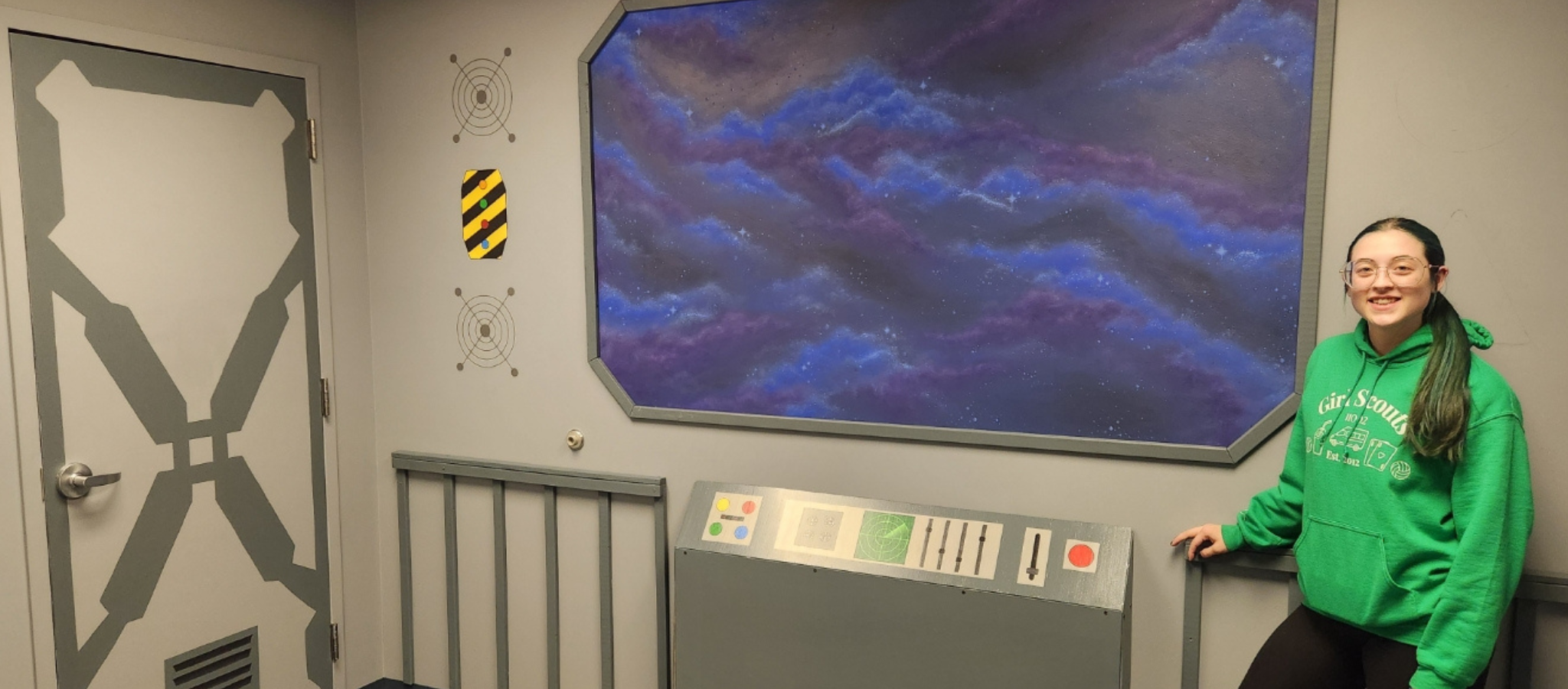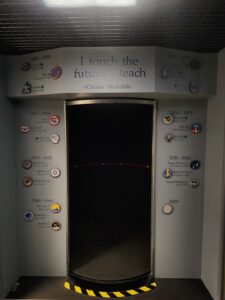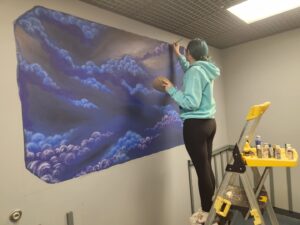Blogs | 8.6.2025
Girl Scout Creates Immersive Space Room at Challenger Learning Center

Tabitha Burk knew she wanted her Girl Scout Gold Award to mean something, but for a while, she wasn’t sure what that “something” would be. The highest honor in Girl Scouting, the Gold Award calls for a project that creates a lasting impact in your community. Tabitha wanted to rise to the challenge, but she didn’t yet have the spark.
 That spark came from a conversation with her troop leader, Heather Townley, who mentioned an underutilized space inside Challenger Learning Center of Lake Erie West. It was a plain, off-white room serving as an airlock. The room transitions students from a realistic transport room to a simulated spacecraft where they perform experiments, acting as astronauts, engineers, and scientists in an immersive mission to space. But the airlock lacked continuity with the rest of the lifelike simulator. It felt more like a forgotten classroom than a portal to the stars.
That spark came from a conversation with her troop leader, Heather Townley, who mentioned an underutilized space inside Challenger Learning Center of Lake Erie West. It was a plain, off-white room serving as an airlock. The room transitions students from a realistic transport room to a simulated spacecraft where they perform experiments, acting as astronauts, engineers, and scientists in an immersive mission to space. But the airlock lacked continuity with the rest of the lifelike simulator. It felt more like a forgotten classroom than a portal to the stars.
 As a lifelong Girl Scout who’d grown up volunteering, leading camps, and building service projects, Tabitha felt drawn to the idea. “I love helping kids, I love creative projects, and I wanted to give back in a way that felt meaningful,” she said. “This was something that combined all of that.”
As a lifelong Girl Scout who’d grown up volunteering, leading camps, and building service projects, Tabitha felt drawn to the idea. “I love helping kids, I love creative projects, and I wanted to give back in a way that felt meaningful,” she said. “This was something that combined all of that.”
With support from her troop, school district leadership, and Challenger Learning Center crew, Tabitha launched a complete reimagining of the airlock. With hand-painted murals and interactive elements, she would turn drab walls into an inspiring space that sparks imagination.
Designing a Space for Wonder
Though it was her first mural, Tabitha approached the transformation with the heart of an artist and the discipline of an engineer. She sketched designs, researched space history, and even built a scale model to present to the superintendent and assistant superintendent.
 “They were nervous at first,” admits Heather Townley, the Coordinator of Gifted STEM and Personalized Learning at the Center. “But she walked in with a plan. She had vision, talent, and a clear purpose. I had zero doubt.” Heather’s confidence was not unwarranted; she’s Tabitha’s troop leader and has known her since she was five.
“They were nervous at first,” admits Heather Townley, the Coordinator of Gifted STEM and Personalized Learning at the Center. “But she walked in with a plan. She had vision, talent, and a clear purpose. I had zero doubt.” Heather’s confidence was not unwarranted; she’s Tabitha’s troop leader and has known her since she was five.
Tabitha’s ambitious vision included handcrafted elements like painted NASA mission patches displayed along a timeline from the 1960s to the present, each chosen for its significance to space exploration. Tabitha even added a special detail: Girl Scout emblems next to patches from missions that included Girl Scouts, honoring the legacy of women in space.
A vinyl-covered wall cleverly hid concrete while mimicking the white fabric used on the International Space Station, and hand-painted mechanical doors, a window to space, and a faux control panel turn the room into a realistic interstellar environment. A sign over the doorway now reads, “Caution: Leads to Space. Oxygen Will Be Depleted”—a playful nod to immersion that’s also a functional traffic cue for students.
And above the airlock door is a quote from Christa McAuliffe, member of the Challenger STS-51L crew: “I touch the future, I teach.”
Fueled by Cookies and Commitment
Remarkably, Tabitha funded the entire project with money she earned selling Girl Scout cookies.
“She’s a cookie hustler,” Heather laughed. “She’s been saving for years, and she put it all into this.”
That hustle came in handy to meet her deadline, considering that while managing the design and build process, Tabitha was also earning her high school diploma and an associate’s degree. This spring, she graduated with both at age 17. Despite the demanding schedule, she met with community leaders, sourced materials, and tackled every challenge that came her way.
One of the toughest parts? Figuring out how to give the illusion that mission patches floated off the wall while hiding their supports. “It had to look polished and seamless,” she said. “I wanted the space to feel finished and authentic, like you were really stepping into another world.”
STEM, Art, and the Power of Passion
 While Tabitha’s talents are creative, her work shows how essential art can be in STEM spaces. “She used what she was passionate about to inspire others to pursue science,” Heather said. “She made the mission feel real.”
While Tabitha’s talents are creative, her work shows how essential art can be in STEM spaces. “She used what she was passionate about to inspire others to pursue science,” Heather said. “She made the mission feel real.”
Through research, design, problem-solving, and even carpentry, Tabitha used STEM skills to bring her vision to life. And in doing so, she showed how creativity and science go hand in hand.
“I learned how to work through a big project. How to keep going even when things get tough,” she reflected. “And how your work, no matter how small or big, really can make a difference.”
Her legacy is now built into the walls of the airlock. Students walk through her creation every day, entering a mission simulation that feels exciting, immersive, and inspiring.
For Tabitha, the next mission is college. She plans to double major in marketing and graphic design. But she’ll always carry with her the experience of transforming a space into something unforgettable.
“It’s really amazing,” she said. “You don’t have to wait until you’re older to make an impact. If you follow what inspires you, you might just inspire others too.”
